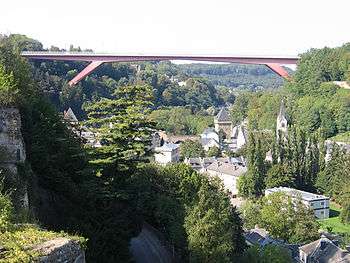Grand Duchess Charlotte Bridge
Coordinates: 49°37′04″N 06°07′51″E / 49.61778°N 6.13083°E

The Grand Duchess Charlotte Bridge (Luxembourgish: Groussherzogin-Charlotte-Bréck, French: Pont Grande-Duchesse Charlotte, German: Großherzogin-Charlotte-Brücke) is a road bridge in Luxembourg City, in southern Luxembourg.
It carries the N51 across the Alzette, connecting the Avenue John Fitzgerald Kennedy, in Kirchberg, to Boulevard Robert Schuman, in Limpertsberg. The bridge is also known as the Red Bridge (Luxembourgish: Rout Bréck, German: Rote Brücke, French: Pont Rouge) on account of its distinctive red paintwork.
It is the main route connecting the city centre, Ville Haute, to Kirchberg, the site of the city's European Union institutions. It was built with the intention of promoting the choice of Luxembourg as the final seat of the European Communities. While the bridge was under construction, the Merger Treaty was signed, maintaining the previous separation of locations, but preserving Luxembourg as the location of several institutions.[1]
German architect Egon Jux designed the bridge, beating 68 competitors in a competition launched by Luxembourg's government in 1957.[2] Construction began in 1962, with official groundbreaking on 20 June 1963 by Charlotte, then Grand Duchess.[3] Construction was finished in 1965, and the bridge opened in October 1966. It is named after Charlotte.
Suicides
Throughout the years the Grand Duchess Charlotte Bridge became more and more known for its suicides. More than 100 people have ended their lives by jumping off the bridge since it opened in 1966. In some point in time there were roadsigns placed, warning the people from falling objects.
It took until 1992 when the Luxembourg director Genevieve Mersch shot a short 21 min. documentary film named "Le Pont Rouge" (The Red Bridge) until the awareness arose that something had to be done to prevent more suicides. In this documentary a couple of families who lived underneath the bridge were followed and interviewed throughout a period of time, telling about their macabre experiences with the bridge. One year after this documentary aired, in 1993 the Luxembourgian government decided to erect a Plexiglas safety barrier to prevent more suicides from happening.
Footnotes
References
- Kinnen, Ferdinand (1967). "Construction de Pont Grande-Duchesse Charlotte" (PDF). Revenue technique luxembourgeoise. 4.
External links
- Grand Duchess Charlotte Bridge at Structurae. Retrieved on 2010-05-25.
- "Pont Grande-Duchesse Charlotte". Administration des ponts et chaussées. 18 July 2007. Retrieved 24 May 2010.
- Le Pont Rouge at the Internet Movie Database
| Wikimedia Commons has media related to Grand Duchess Charlotte Bridge. |